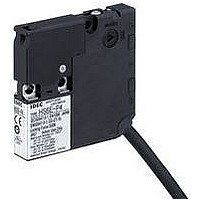HS6E-M7Y4B03-G IDEC, HS6E-M7Y4B03-G Datasheet - Page 13

HS6E-M7Y4B03-G
Manufacturer Part Number
HS6E-M7Y4B03-G
Description
SWITCH, SAFETY INTERLOCK, 2NC, 2A
Manufacturer
IDEC
Series
HS6Er
Datasheet
1.HS6E-L44B03-G.pdf
(20 pages)
Specifications of HS6E-M7Y4B03-G
Contact Voltage Ac Max
125V
Contact Voltage Dc Max
30V
Contact Current Ac Max
2A
Contact Current Dc Max
2A
Switch Terminals
Cable
Contact Configuration
SPST-NC / SPST-NC
Rohs Compliant
Yes
Lead Free Status / RoHS Status
Lead free / RoHS Compliant
(07/03/12)
• In order to avoid electric shock or fire, turn power off before
• If relays are used in the circuit between the interlock switch
• Do not place a PLC in the circuit between the interlock
• Regardless of door types, do not use the interlock switch
• Do not apply external force on the actuator while
• Do not apply excessive shock to the interlock switch when
• If the operating atmosphere is contaminated, use a
• Entry of a considerable amount of foreign objects into the
• Do not store the interlock switches in a dusty, humid, or
• Use proprietary actuators only. When other actuators are
• The locking strength is rated at 500N. Do not apply a load
• Regardless of door types, do not use the interlock switch
• While the solenoid is energized, the switch temperature
• Bouncing will occur on the lock monitor contact during
• Although the HS9Z-A61/A62/A62S actuators alleviate
installation, removal, wiring, maintenance, or inspection of
the interlock switch.
and the load, use only safety relays, since welded or stick-
ing contacts of standard relays may invalidate the functions
of the interlock switch. Perform a risk assessment and
make a safety circuit which satisfies the requirements of
the safety category.
switch and the load. Safety security can be endangered in
the event of a malfunction of the PLC.
as a door stop. Install a mechanical door stop at the end of
the door to protect the interlock switch against excessive
force.
unlocking, otherwise the actuator may not be unlocked.
opening or closing the door. A shock to the interlock switch
exceeding 1,000 m/s
switch.
protective cover to prevent the entry of foreign objects into
the interlock switch through the actuator entry slots.
interlock switch may affect the mechanism of the interlock
switch and cause a malfunction.
organic-gas atmosphere, or in an area subjected to direct
sunlight.
used, the interlock switch may be damaged.
higher than the rated value. When a higher load is
expected, provide an additional system consisting of
another interlock switch without lock (such as the HS6B/
HS7A interlock switch) or a sensor to detect door opening
and stop the machine.
as a door lock. Install a separate lock using a latch or other
measures.
rises approximately 35°C above the ambient temperature
(to approximately 85°C while the ambient temperature is
50°C). Do not touch to prevent burns. If cables come into
contact with the switch, use heat-resistant cables.
locking and unlocking (reference value: 20 ms).
shock when the actuator enters a slot in the interlock
switch, make sure that excessive shock is not applied.
If the rubber bushings become deformed or cracked,
replace with new ones.
Safety Precautions
Instructions
2
may cause damage to the interlock
HS6E Subminiature Interlock Switches with Solenoid
• Do not disassemble or modify the interlock switch, other-
• Do not install the actuator in a location where a human
• Solenoid lock type is locked when energized, and unlocked
Minimum Radius of Hinged Door
• When using the interlock switch on hinged doors, refer to
Note: Because deviation or dislocation of hinged doors may occur
When using the HS9Z-A62/A62S Right-angle Actuator
• When the door hinge is on the extension line of the interlock switch
• When the door hinge is on the extension line of the interlock switch
surface:
surface:
wise a malfunction or an accident may occur.
body may come in contact. Otherwise injury may occur.
when de-energized. When energization is interrupted due
to wire disconnection or other failures, the interlock switch
may be unlocked causing possible danger to the operators.
Solenoid lock type must not be used in applications where
locking is strictly required for safety. Perform a risk assess-
ment and determine whether solenoid lock type is appro-
priate.
the minimum radius of doors shown below. When using on
doors with small minimum radius, use the angle adjustable
actuator (HS9Z-A65 and HS9Z-A66).
in actual applications, make sure of the correct operation
before installation.
Door Hinge
Door Hinge
Door Hinge
Door Hinge
13












